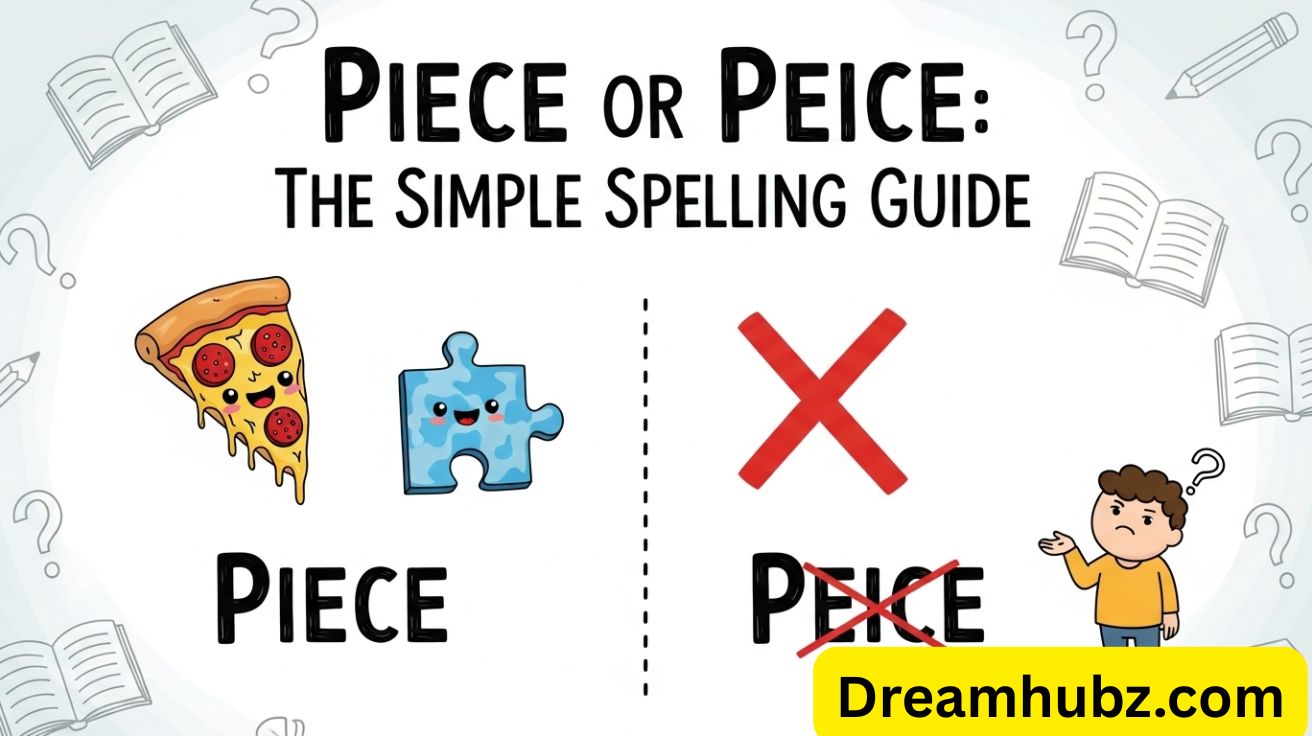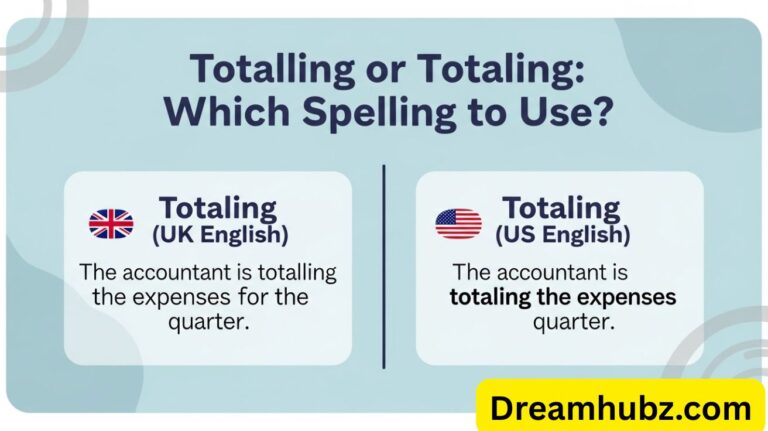Piece or Peice: The Simple Spelling Guide
“Piece or peice” is a common spelling problem in English. The correct spelling of piece means a part, portion, or segment of something. The word peice has no meaning and is always wrong. It is simply one of the many common English misspellings.
Have you ever written “peice” by mistake? Many learners do it because of the confusing I before E rule. This mistake happens in schools, workplaces, and even online posts. Knowing the difference saves you from simple errors.
The truth is simple: piece vs peice is not a real debate. “Piece” is correct in all English uses. “Peice” is never accepted. Learning the right spelling improves writing clarity and professionalism everywhere.
Understanding the Correct Spelling: “piece or peice”

When it comes to the word “piece,” there is no debate. The correct form is piece. The word peice meaning (misspelling) does not exist in any English dictionary. However, because of the confusing I before E rule, many people wrongly believe that “peice” looks correct. In reality, this is one of those cases where the rule has exceptions.
Here is a simple table to remember the difference:
| Word | Correct/Incorrect | Meaning |
| Piece | ✅ Correct | A part, portion, or segment of something |
| Peice | ❌ Incorrect | Not a real English word |
So, if you are ever asking yourself piece or peice which is correct, the answer is always piece.
Definition and Meaning
The piece definition is simple yet flexible. A piece is a part of a whole, a portion, or a unit of something. For example, you can say “a piece of cake,” “a piece of jewelry,” or “a piece of advice.” In all these cases, piece examples in sentences show that the word refers to one part of something larger.
The word is also used in a more abstract way. For instance, in art or literature, a “piece” might mean an individual work, such as “a music piece” or “a news piece.” This wide range of meaning shows the correct use of piece across different contexts.
Key Characteristics of “Piece”
One reason the word “piece” is so common is because it works in many situations. It can describe physical objects like paper or food, but it can also represent abstract ideas such as advice or information. It is both a countable noun (a piece, two pieces) and an uncountable concept (peace of mind, piece of information).
Another characteristic is its use in expressions. In American English, we often hear idioms like “a piece of cake” meaning something is easy, or “to give someone a piece of your mind,” which means to express anger or honesty. These idioms are a big part of everyday English, making “piece” a word that learners should master early.
Etymology and History of “Piece”
Origins in Latin and Old French
The history of English words often goes back to Latin and French. The word etymology in English for “piece” begins with the Vulgar Latin word “petia,” meaning a portion or fragment. This word was adopted into Old French as “piece,” where it held a similar meaning.
Adoption into Middle English
By the 13th century, “piece” was borrowed into Middle English. Writers and scholars of the time used it to describe portions of material things, and over time it gained wider meanings.
Modern Usage and Versatility
In modern American English, “piece” is extremely versatile. It can mean anything from a slice of pizza to a masterpiece of art. The expansion of its use makes it one of the most common nouns in the English language.
A Global Perspective
Globally, the spelling remains the same in the U.S., U.K., Canada, and Australia. However, idiomatic usage may differ slightly. For example, Americans frequently say “a piece of work” to describe a difficult person, while in British English it may carry a slightly different nuance.
Everyday Usage of “Piece”
In daily conversations, “piece” shows up everywhere. We ask for a piece of paper, buy a piece of jewelry, and eat a piece of bread. The word also appears in figurative speech, such as “a piece of history” or “a piece of advice.”
In the United States, idioms are especially common. Saying “this test was a piece of cake” means the test was easy. Expressions like these show why the correct spelling of piece is so important. If you write “peice of cake,” it not only looks wrong but also affects writing clarity and professionalism.
The Common Error: “Peice”
What Is “Peice”?
The word peice is not recognized in English. It is simply a spelling mistake. Many people type it by accident, especially when rushing.
Why Do People Misspell “Piece”?
The main reason is the confusing I before E rule taught in schools: “I before E except after C.” But English is full of exceptions, and “piece” is one of them. In reality, the correct form goes against the rhyme, which is why learners fall into the trap of writing “peice.”
Examples of Common Errors
Writers often produce incorrect phrases like “peice of cake,” “art peice,” or “game peice.” These are all wrong. Correct forms should be “piece of cake,” “art piece,” and “game piece.”
Why Spelling Accuracy Matters

Clarity and Professionalism
Correct spelling is not just about rules—it is about professional writing skills. Using the correct spelling of piece ensures your writing is clear and respected. Employers, teachers, and readers all notice mistakes, and frequent errors can hurt credibility.
The Ripple Effect of Misspellings
One wrong word can spread. If you write “peice” in an email or post, others may copy it, spreading the mistake further. This is one reason spelling accuracy importance is emphasized in schools and professional writing.
Cognitive Load on Readers
Psychologists explain that errors create extra mental work for readers. A misspelling like “peice” forces readers to pause and mentally correct it, breaking their focus. This unnecessary cognitive load reduces comprehension and flow.
Tools and Strategies for Correct Spelling
1. Use Spell Checkers
Modern technology makes spelling easier. Built-in spelling checker apps (Grammarly, Microsoft Word, Google Docs) underline mistakes instantly, preventing errors before publishing.
2. Leverage Grammar Tools
Beyond spell check, grammar and spelling tools like ProWritingAid or Hemingway App provide proofreading tips to polish your writing and catch mistakes such as “peice.”
3. Mnemonics to Remember “Piece”
Spelling mnemonics are powerful. One common trick is to remember “A piece of pie.” Since PIE is inside the word “piece,” it helps you spell it correctly every time. These spelling tips and tricks are useful for both beginners and advanced writers.
4. Follow Style Guides
Professional writers rely on spelling guide English standards like APA, MLA, and Chicago Manual of Style. Following a guide ensures consistency and strengthens writing clarity and professionalism.
Read Also : Understanding “Princess’ or Princess’s” – The Complete Guide
Examples of “Piece” in Real-Life Scenarios
Cooking and Food
In American kitchens, we often hear “a piece of cake,” “a piece of pizza,” or “a piece of chicken.” These piece examples in sentences make it easy for beginners to see how the word works.
Art and Literature
Artists talk about an “art piece,” and journalists write “a news piece.” In literature, “a piece of poetry” refers to an individual work. These examples show the word’s artistic and cultural value.
Idioms and Expressions
English is full of idioms. “Pick up the pieces” means to recover from failure. “Give someone a piece of your mind” means to scold them. It is also important to avoid mix-ups with homophones. For example, people often confuse “piece of mind” with “peace of mind.” The first is incorrect, while the second is the proper form. This shows how homophones and spelling errors can cause confusion.
Professional Scenarios
In business, people may refer to “a piece of data” or “a piece of writing.” In journalism, a “feature piece” means an in-depth article. Accuracy in these cases demonstrates strong professional writing skills.
The Confusion Between Piece and Peace
Many English learners often confuse piece vs peace because the two words sound the same but have very different meanings. Piece spelling refers to a portion or part of something, while peace means calmness or harmony. This is a classic example of homophones and spelling errors that cause trouble for beginners.
In professional writing, mixing up “piece” and “peace” can lead to embarrassment. Imagine writing “a peace of cake” instead of “a piece of cake.” It looks unprofessional and changes the meaning entirely. Correcting these common English misspellings is essential for writing clarity and professionalism, especially in academic or business contexts.
The Role of Memory Tricks in Spelling
Using spelling mnemonics is a powerful way to remember tricky words like “piece.” One common phrase is “A piece of pie,” where the letters PIE are inside the word itself. This small trick works as a memory tool, especially for students and beginners learning how to spell piece correctly.
Mnemonics are not just fun; they also reduce errors in everyday writing. Research shows that learners who use spelling tips and tricks make fewer mistakes over time. These strategies are helpful for building long-term confidence and preventing mistakes such as writing “peice.” They are a key part of any spelling guide English for beginners.
Why American English Prioritizes Spelling Accuracy

In the United States, spelling is often tied to professionalism. Writers are expected to use correct spelling of piece and avoid obvious mistakes like “peice.” Employers, educators, and even casual readers value accuracy because it reflects care and attention to detail in communication.
This emphasis on spelling accuracy importance is also why schools focus heavily on spelling tests. By reducing common spelling errors, learners develop stronger professional writing skills. American English continues to stress clear spelling because it improves understanding and ensures trust between writers and readers.
The Impact of Misspellings Online
The internet has made writing more public than ever, and spelling errors are now visible to a wide audience. When people write “peice” instead of “piece,” the error spreads quickly through social media, blogs, and forums, creating confusion among readers. This is an example of the ripple effect of misspellings.
Even small mistakes lower credibility. Readers often judge professionalism by spelling quality. Using the correct use of piece shows reliability, while “peice” looks careless. This makes proofreading tips and grammar and spelling tools essential for online content creators, bloggers, and professionals who publish digital writing.
Case Study: Spelling Errors in Professional Emails
A recent survey found that 59% of U.S. professionals believe that spelling mistakes in English reduce trust in business communication. Words like “peice” often appear in emails written quickly without using a spelling checker app. These mistakes can leave a lasting impression on clients or managers.
For example, an employee once sent “Please review the peice attached” in a company report. The small error distracted the reader and reduced the overall professionalism of the document. Simple proofreading tips like reading emails aloud or using Grammarly, Microsoft Word, or Google Docs can prevent such costly mistakes in professional communication.
FAQ,s
Is it spelled peice or piece?
It is always spelled piece, never peice.
What does peice mean?
Peice has no meaning; it is simply a misspelling.
How do you spell piece in English?
You spell it correctly as p-i-e-c-e.
Is “peice” ever a correct spelling?
No, peice is never correct in English.
Conclusion
The debate of piece vs peice is easy to solve: “piece” is correct, and “peice” is always wrong. Understanding the piece definition, learning from Latin and French word origins, and practicing with spelling tips and tricks will help avoid mistakes. Remember that spelling accuracy importance goes beyond grammar—it affects how others see your intelligence, professionalism, and credibility.
So, next time you write “a piece of cake” or “an art piece,” make sure you spell it correctly. With tools like Grammarly, style guides, and spelling mnemonics, you can master spelling for beginners and experts alike. Accuracy in language is more than rules—it is respect for your readers.







